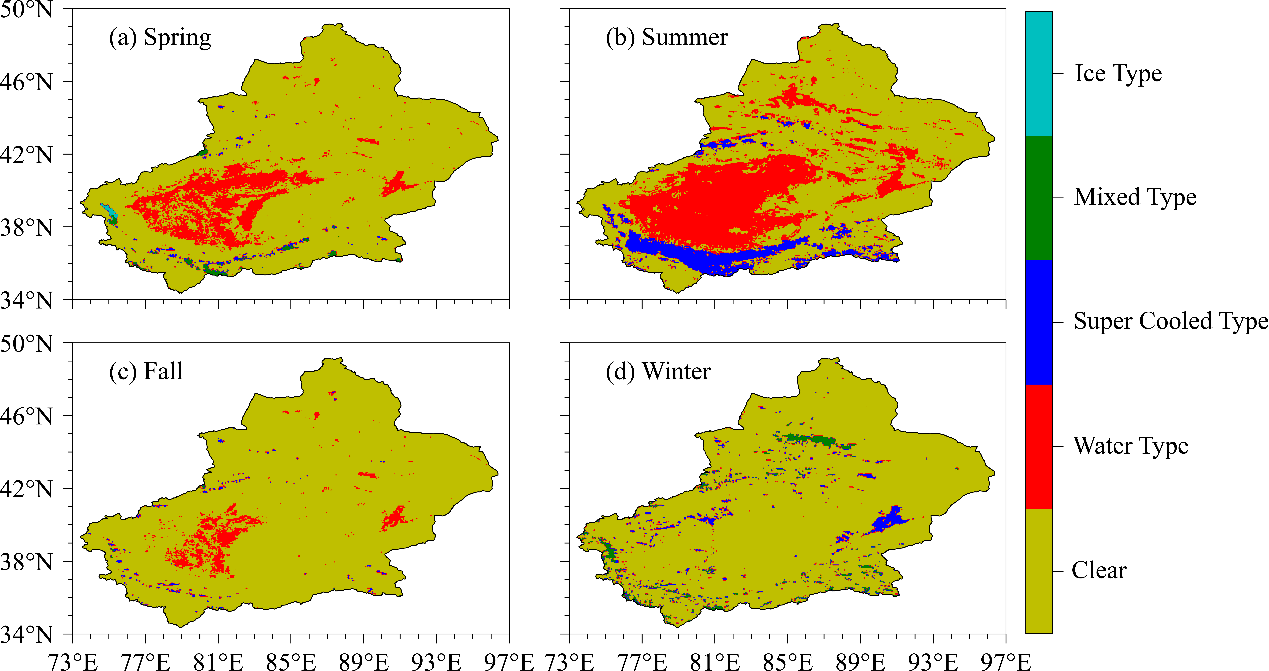
Research Highlight

The precise distribution characteristics and detailed variation trends of cloud water resources are a fundamental prerequisite and key scientific issue for the scientific and rational development and utilization of cloud water resources. Understanding the status of cloud water resources in Xinjiang is of significant strategic importance for the scientific and rational development of cloud water resources in Xinjiang, effectively alleviating water resource shortages in Xinjiang, improving the ecological environment in Xinjiang, and ensuring the sustainable development of Xinjiang’s socio-economy.

Figure 1. The seasonal variation in the spatial distribution of CLT with the highest frequency among the seven types of CLT.
The Central Asia Weather and Cloud-Precipitation Physics Research Team at the Desert Institute utilized hourly total cloud cover (TCC) data from the Fengyun-4A satellite (FY-4A), ERA5 reanalysis data, and ground meteorological station observations in Xinjiang (GROB) to investigate the seasonal variation characteristics of cloud water resources in Xinjiang. The results indicate that the TCC data from FY-4A, GROB, and ERA5 all effectively reflect the significant seasonal variations in Xinjiang’s TCC. The average TCC is highest (lowest) in spring (autumn), with a distribution pattern of higher values in the southwest (northwest) and lower values in the northeast (southeast). The spatial distribution of different cloud types (clear type, water type, supercooled water type, mixed type, ice type, cirrus type, and overlap type) in FY-4A exhibits distinct seasonal variation characteristics. In summer, the water type (supercooled water type) high-frequency center exceeds 30% in the Tarim Basin (Kunlun Mountains). The mixed type (ice type and cirrus type) has the highest frequency in winter (spring), while the multi-layer type has the highest frequency in summer. In Xinjiang, TCC is positively correlated with water vapor conditions. The findings of this study are of great significance for understanding the seasonal variations in Xinjiang's cloud water resources and for the scientific and rational development of these resources. Additionally, the results can provide references for effectively alleviating water shortages in Xinjiang, promoting agricultural and pastoral development, and improving the ecological environment.
The relevant findings were published in Remote Sensing under the title “Seasonal Variation in Total Cloud Cover and Cloud Type Characteristics in Xinjiang, China Based on FY-4A” with Zeng Yong from IDM as the first author. The study was supported by the Tianshan Talent Leadership Program of Xinjiang (2022TSYCLJ0003), the National Natural Science Foundation of China (42305080), Xinjiang Key Research and Development Program Project (2023B03019-1), Xinjiang Natural Science Foundation (2022D01B227), and the Science and Technology Development Fund of IDM (KJFZ202401).
Original information: Zeng, Y.; Yang, L.; Tong, Z.; Jiang, Y.; Zhou, Y.; Lu, X.; Abulikemu, A.; Li, J. Seasonal Variation in Total Cloud Cover and Cloud Type Characteristics in Xinjiang, China Based on FY-4A. Remote Sens. 2024, 16, 2803.
Article link: https://doi.org/10.3390/rs16152803.

0991-2652429

desert@idm.cn

新疆维吾尔自治区乌鲁木齐市建国路327号


Scan to follow
us on WeChat